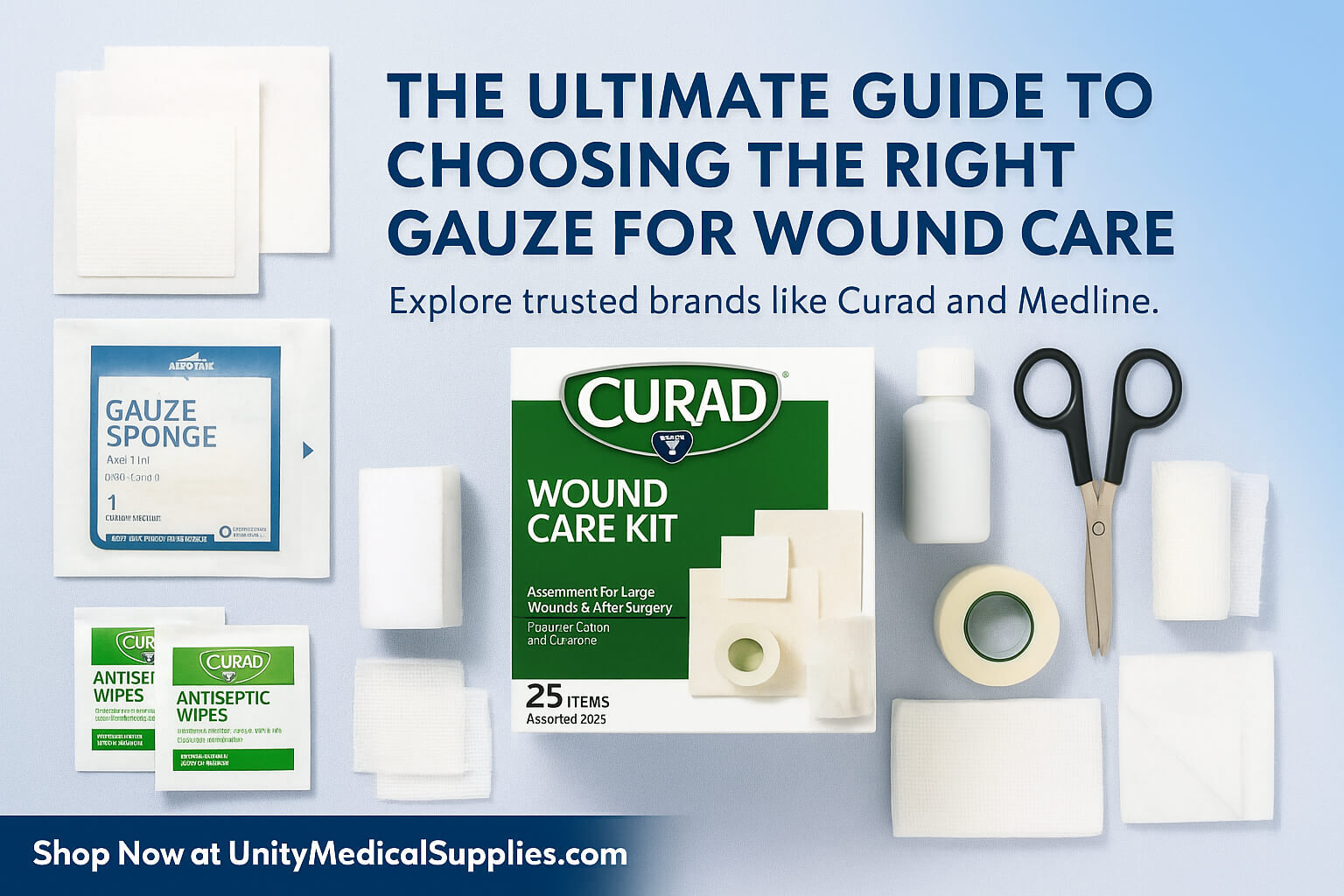The Ultimate Guide to Choosing the Right Gauze for Wound Care
Published by UnityMedicalSupplies on Oct 6th 2025
The Ultimate Guide to Choosing the Right Gauze

Choosing the right gauze can make a big difference in comfort, protection, and healing outcomes. Whether you’re a clinician stocking a supply room, a sports trainer preparing a kit, or a parent refreshing a home first-aid cabinet, this guide explains the key types of gauze, when to use each, and how to pick the best option for your needs. You’ll also find quick links to our Wound Care and Gauze categories, plus a curated product list ready to ship. Reminder: We offer free ground shipping on all orders over $50, and select items ship free every day.
Introduction
Gauze is a foundational material in first aid and clinical wound management. It supports cleansing, absorption of exudate, and protection from contaminants, and can be used as a primary or secondary dressing depending on wound type and stage. Understanding the differences—sterility, fiber type, ply, size, and specialty coatings—helps you make confident choices for at-home care or professional use.
A Closer Look at Gauze
What Is Gauze?
Gauze is a thin, open-weave fabric—commonly cotton, synthetic fibers, or blends—used in dressings and bandages. Its structure helps absorb fluids, protect the wound from debris, and maintain a cleaner environment under secondary wraps or tapes. Depending on construction and finish, gauze can prioritize absorbency, non-adherence, or conformability.
Types of Gauze and Their Uses
Sterile Gauze
Best for direct wound contact and first aid, sterile gauze is free of microorganisms, making it appropriate as a primary dressing on minor cuts, abrasions, and post-procedure sites. Use sterile pads or rolls for cleansing, packing as directed, and covering wounds before securing with a secondary dressing.
Non-Sterile Gauze
Designed for non-contact applications, non-sterile gauze is useful as a secondary layer for cushioning and absorption, or for general cleaning tasks around—not on—open wounds. It’s also helpful for securing splints or protecting skin under wraps.
Impregnated Gauze
Impregnated gauze is saturated with substances like petrolatum (petroleum), antibacterial agents, or specialty wound interface gels. It helps maintain a moist environment and reduces sticking to delicate tissue—ideal when non-adherence is a priority or when gentle removal is important.
Woven vs. Non-Woven
- Woven cotton gauze: traditional, strong, and breathable; may be slightly more linty; good tensile strength.
- Non-woven (synthetic blends): low-lint, often more absorbent per ply, and can feel softer; great for sensitive skin and procedures where minimal lint is preferred.
Pads, Sponges, and Rolls
- Gauze pads/sponges: flat squares for cleansing and covering.
- Gauze rolls: continuous bandage material for conforming wraps, securing dressings, and light compression per clinician direction.
- Sizes & ply: choose smaller pads for minor cuts; larger or multilayer pads for higher drainage. Higher ply and non-woven options often improve absorption.
Quick Comparison Table
| Type | Best For | Key Benefits | Considerations |
|---|---|---|---|
| Sterile Gauze | Primary wound contact | Clean, safe for open wounds | Single-use; choose size/ply for exudate |
| Non-Sterile Gauze | Secondary layers; general cleaning | Economical cushioning/absorption | Not for direct wound contact |
| Impregnated Gauze | Non-adherent interface, moist healing | Helps prevent sticking; gentler removal | Higher cost; use as directed |
| Woven vs. Non-Woven | General use vs low-lint, high absorbency | Strength (woven) vs softness/absorbency (non-woven) | Lint sensitivity; comfort preferences |
Selecting the Right Gauze: A Practical Checklist
- Define the job: Primary dressing (sterile, appropriate ply) or secondary wrap (non-sterile acceptable)?
- Control exudate: Heavier drainage often benefits from higher ply or more absorbent non-woven options.
- Minimize adherence: Consider impregnated/petrolatum gauze for fragile or sensitive tissue where sticking is a concern.
- Choose the format: Pads for coverage, rolls for conformability and securing.
- Comfort & sensitivity: Cotton for classic softness; non-woven for low lint and plush feel.
- Keep it stocked: Pair gauze with tapes, cotton balls, ointments, and a kit for quick response.
Explore more options in our Gauze and Wound Care categories. Free ground shipping on orders over $50.
Featured Products (In Stock & Ready to Ship)

CURAD Wound Care Kit, Assorted Sizes, 25 count, 12 kits/case
A ready-to-go assortment for home, school, or workplace first aid. Great pairing with gauze pads and rolls to cover and secure dressings. Free Ground Shipping.

Medline Sterile Cotton Gauze Bandage Roll, 4.5" x 4.1 yd.
Classic, conformable sterile roll for primary or secondary dressings. Ideal when you need breathable coverage and easy wrapping around joints or contoured areas.

CURAD Sterile Cotton Balls, Size M, 1", 130 balls/box, 24 boxes/case
Versatile sterile cotton balls to aid cleansing, prepping, or applying topical solutions around the wound site. A useful complement to gauze pads and rolls.
Browse more options in Gauze and complete your kit in Wound Care. Free ground shipping on orders over $50.
Examples of Good Gauze Choices
- Sterile Gauze Pads/Rolls: For direct wound contact or wrapping over primary dressings. See Medline Sterile Cotton Gauze Bandage Roll.
- Non-Sterile Gauze: Secondary layers and general cleaning (not on open wounds). Explore options in Gauze.
- Impregnated Gauze: Petrolatum or specialty agents for non-adherence and moist healing (use per clinician guidance).
- Complete Kits: For home, school, travel, or workplace coverage, the CURAD Wound Care Kit simplifies selection and ships free.
Conclusion
The “right” gauze depends on your role (clinician, caregiver, athlete, parent), the wound’s needs (exudate level, sensitivity), and how you’ll secure and change dressings. Use sterile gauze for primary contact, non-sterile for secondary layers, and consider impregnated options to reduce sticking on fragile tissue. Keep complementary items—cotton balls, tapes, and a well-stocked kit—on hand for confident care.
